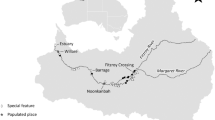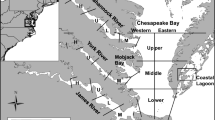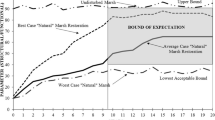Synopsis
Because estuarine nekton are ‘integrators of the environment’ abiotic and biotic factors can influence or constrain the relative value of estuarine nursery zones. Recent laboratory experiments on young spot, Leiostomus xanthurus, indicate that both water temperature and salinity significantly affect somatic growth. These experimental data contrast with previous work on young Atlantic croaker,Micropogonias undulatus, white trout,Cynoscion arenarius, and mullet,Mugil sp. Together these results suggest that quantifying vital metrics of nekton, such as survival and growth, along realistic environmental gradients through critical laboratory experiments, allows a more accurate definition of constraints on habitat use. Our studies of factors influencing recruitment success in both winter- and spring/summer-spawning fishes illustrate seasonal as well as intrafamilial differences in growth. Effective management of coastal ecosystems must take into account both variability in abiotic conditions and the nested habitat component, both of which can be modified by coastal development, which could lead to reduced productivity and sustainability of these estuarine landscapes.
Similar content being viewed by others
References
D.M. Baltz J.W. Fleeger J.N. RakocinskiC.F. McCall (1998) ArticleTitleFood, density, and micro-habitat: factors affecting growth and recruitment potential of juvenile saltmarsh fishes Environ. Biol. Fish. 53 89–103
M.W. Beck K.L. Heckc SuffixJr. K.W. Able D.L. Childers D.B. Eggleston B.M. Gillanders B. Halpern C.G. Hays K. Hoshino T.J. Minello R.J. Orth P.F. Sheridan M.P. Weinstein (2001) ArticleTitleThe identification, conservation, and management of estuarine and marine nurseries for fish and invertebrates Bioscience 51 633–641
L.R. Belyea J. Lancaster (1999) ArticleTitleAssembly rules within a contingent ecology Oikos 86 402–416
Cardona L. (2000) ArticleTitleEffects of salinity on the habitat selection and growth performance of Mediterranean flathead grey mullet Mugil cephalus (Osteichthyes, Mugilidae) Estuar. Coast. Shelf Sci. 50 727–737
J.K. Craig L.B. Crowder (2000) Factors influencing habitat selection in fishes with a review of marsh ecosystems. M.P. Weinstein D.A. Kreeger (Eds) Concepts and Controversies in Tidal Marsh Ecology Kluwer Academic Publishers Dordrecht 241–265
L.A. Deegan (1993) ArticleTitleNutrient and energy transport between estuaries and coastal marine ecosystems by fish migration Can. J. Fish. Aquat. Sci. 50 74–79 Occurrence Handle10.1139/f93-009
E. Demers S.B. Brandt K.L. Barry J.M. Jech (2000) Spatially explicit models of growth rate potential Linking estuarine fish production to the biological and physical environment J.E. Hobbie (Eds) Estuarine Science A Synthetic Approach to Research and Practice Island Press Washington, D.C. 405–425
D.M. Goshorn C.E. Epifanio (1991) ArticleTitleDevelopment, survival, and growth of larval weakfish at different prey abundances Trans. Am. Fish. Soc. 120 693–700
P.A. Grecay T.E. Targett (1996) ArticleTitleEffects of turbidity, light level and prey concentration on feeding of juvenile weakfish Cynoscion regalis Mar. Ecol. Progr. Ser. 131 11–16
P.A. Grecay T.E. Targett (1996) ArticleTitleSpatial patterns in condition and feeding of juvenile weakfish in Delaware Bay Trans. Am. Fish. Soc. 125 803–808
T.E. Lankford SuffixJr. Targett. T.E. (1994) ArticleTitleSuitability of estuarine nursery zones for juvenile weakfish (Cynoscion regalis): effects of temperature and salinity on feeding, growth and survival Mar. Biol. 119 611–620
K.D. Malloy T.E. Targett (1991) ArticleTitleFeeding, growth and survival of juvenile summer flounder (Paralichthyes dentatus): experimental analysis of the effects of temperature and salinity Mar. Ecol. Progr. Ser. 72 213–223
K.D. Malloy T.E. Targett (1994) ArticleTitleEffects of ration limitation and low temperature on growth, biochemical condition, and survival of juvenile summer flounder from two Atlantic coast nurseries Trans. Am. Fish. Soc. 123 182–193
J.F.K. Marais (1978) ArticleTitleRoutine oxygen consumption of Mugil cephalus,Liza dumerili and L. richardsoni at different temperatures and salinities Mar. Biol. 50 9–16
L. Meng S.A. Matern (2001) ArticleTitleNative and introduced larval fishes of Suisan Marsh, California: the effects of freshwater flow Trans. Am. Fish. Soc. 130 750–765
J.M. Miller M.L. Dunn (1980) Feeding strategies and patterns of movement in juvenile estuarine fishes. V.S Kennedy (Eds) Estuarine Perspectives Academic Press, inc. New York 437–448
J.M. Miller W.H. Neill K.A. Duchon S.W. Ross (2000) Ecophysiological determinants of secondary production in salt marshes: a simulation study. M.P. Weinstein D.A. Kreeger (Eds) Concepts and Controversies in Tidal Marsh Ecology Kluwer Academic Publishers Dordrecht 315–331
M.L. Moser L.R. Gerry (1989) ArticleTitleDifferential effects of salinity changes on two estuarine fishes, Leiostomus xanthurus and Micropogonias undulatus Estuaries 12 35–41 Occurrence Handle1:CAS:528:DyaL1MXitVOntb0%3D
M.L. Moser W.F. Hettler (1989) ArticleTitleRoutine metabolism of juvenile spot,Leiostomus xanthurus, (Lacepede), as a function of temperature, salinity, and weight J. Fish. Biol. 35 703–707
M.L. Moser J.M. Miller (1994) ArticleTitleEffects of salinity fluctuation on routine metabolism of juvenile spot, Leiostomus xanthurus J. Fish. Biol. 45 335–340
Neill W.H. J.M. Miller H.W. Veer ParticleVanDer K.O. Winemiller (1994) ArticleTitleEcophysiology of marine fish recruitment: a conceptual framework for understanding interannual variability Neth. J. Sea Res. 32 135–152
F.G. Nordlie W.A. Szelistowski W.C. Nordlie (1982) ArticleTitleOntogenesis of osmotic regulation in the striped mullet, Mugil cephalus L J. Fish. Biol. 20 79–86
R. Paperno T.E. Targett P.A. Grecay (1997) ArticleTitleDaily growth increments in otoliths of juvenile weakfish, Cynoscion regalis: experimental assessment of changes in increment width with changes in feeding rate, growth rate, and condition factor Fish. Bull. U.S. 95 521–529
Pattillo, M.E., T.E. Czapla, D.M. Nelson M.E. Monaco. 1997. Distribution and abundance of fishes and invertebrates in Gulf of Mexico estuaries Volume II: species life history summaries. ELMR Report Number 11. NOAA/NOS Strategic Environmental Assessments Division, Silver Springs, Maryland.
K.T. Perez (1969) ArticleTitleAn orthokinetic response to rates of salinity change in two estuarine fishes Ecology 50 454–457
M.S. Peterson (2003) ArticleTitleA conceptual view of environment-habitat-production linkages in tidal-river estuaries Rev. Fish. Sci. 11 IssueID4 291–313
M.S. Peterson M.R. Meador (1994) ArticleTitleEffects of salinity on freshwater fishes in coastal plain drainages in the Southeastern U.S. Rev Fish. Sci. 2 95–121 Occurrence Handle10.1080/10641269409388554
M.S. Peterson S.T. Ross (1991) ArticleTitleDynamics of littoral fishes and decapods along a coastal river-estuarine gradient Estuar. Coast. Shelf Sci. 33 467–483
M.S. Peterson B.H. Comyns C.F. Rakocinski G.L. Fulling (1999) ArticleTitleDoes salinity affect growth in juvenile Atlantic croaker, Micropogonias undulatus(Linnaeus)? J Exp. Mar. Biol. Ecol. 238 199–207
M.S. Peterson C.F. Rakocinski B.H. Comyns G.L. Fulling (2000) ArticleTitleLaboratory growth responses of juvenile Mugil sp. to temperature and salinity: delineating optimal field growth conditions Proc. Gulf Caribb. Fish. Inst. 51 341–352
C.F. Rakocinski B.H. Comyns M.S. Peterson G.A. Zapfe (2002) ArticleTitleField growth responses of juvenile white trout (Cynoscion arenarius) to continuous variation in physical habitat conditions Proc. Gulf Caribb. Fish. Inst. 53 623–635
W.E. Ricker (1975) ArticleTitleComputation and Interpretation of Biological Statistics of Fish Populations Bull. Fish. Res. Board Can. 191 382
K.A. Rose (2000) ArticleTitleWhy are quantitative relationships between environmental quality and fish populations so elusive? Ecol Appl. 10 285–367
S.W. Ross (2003) ArticleTitleThe relative value of different estuarine nursery areas in North Carolina for transient juvenile marine fishes Fish. Bull., U.S. 101 384–404
D.H. Secor Gunderson T.E. K. Karlsson (2000) ArticleTitleEffect of temperature and salinity on growth performance in anadromous (Chesapeake Bay) and nonanadromous (Santee-Cooper) strains of striped bass Morone saxatilis Copeia 2000 291–296
J.R. Spotila E.A. Standora D.P. Easton P.S. Rutledge (1989) ArticleTitleBioenergetics, behavior, and resource partitioning in stressed habitats: biophysical and molecular approaches Physiol. Zool. 62 253–285 Occurrence Handle1:CAS:528:DyaL1MXltlWjsrc%3D
Author information
Authors and Affiliations
Corresponding author
Rights and permissions
About this article
Cite this article
Peterson, M.S., Comyns, B.H. & Rakocinski, C.F. Defining the fundamental physiological niche of young estuarine fishes and itsrelationship to understanding distribution, vital metrics, and optimal nurseryconditions. Environ Biol Fish 71, 143–149 (2004). https://doi.org/10.1007/s10641-003-0302-1
Received:
Accepted:
Issue Date:
DOI: https://doi.org/10.1007/s10641-003-0302-1




